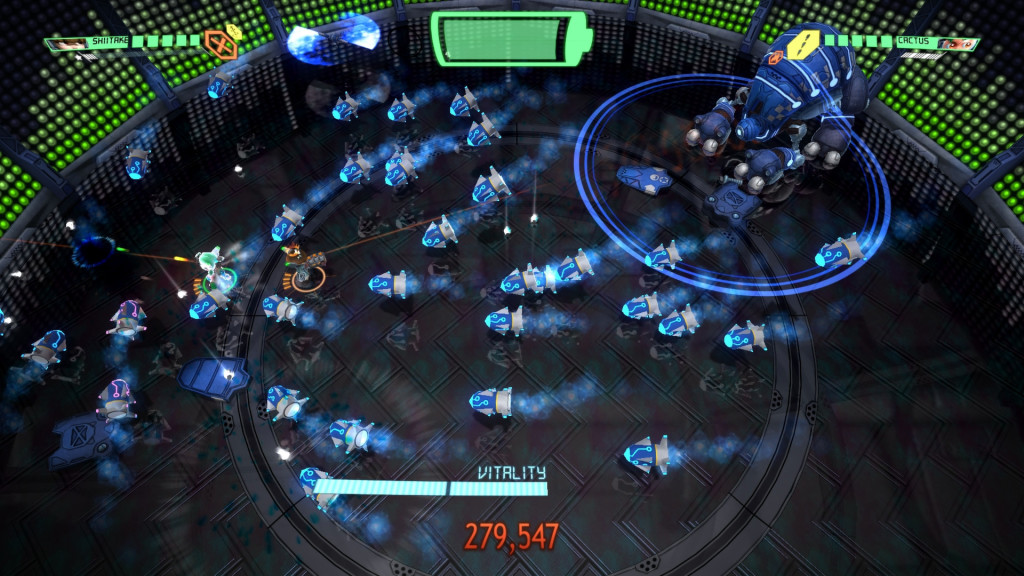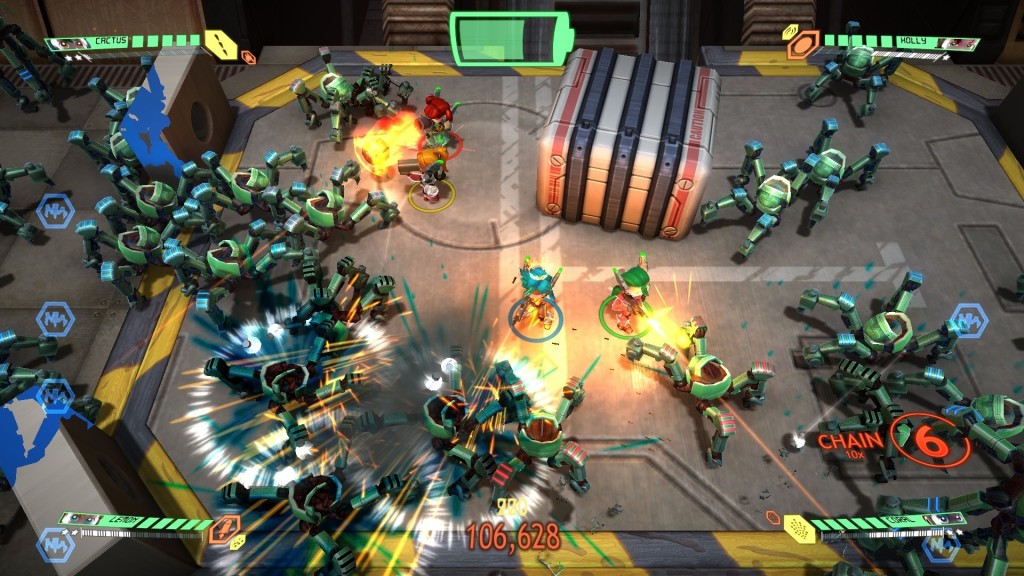Bodacious Bossy Bullet-Hell for Four Buds!
Assault Android Cactus shows off how amazing 4-player boss-shooting can be. The intensity of these focused single-screen battles made us constantly say, “Again!” as we plunged back into battle for the fifteenth time.
You and your shoot-buds share the same battery source. And while most twin-stick shooters require keeping enemies away, Assault Android Cactus forces you to rush into a bullet hellish pit to snag that battery pickup at the last second. If that battery power hits zero, everybody’s dead. This shared-life source means you must “KILL ALL THE THINGS” as fast as possible. Time is life. Instead of losing lives when you take one too many hits, you face a fate worse than death: the dreaded Time Out. Squeeze your triggers as fast as possible to get back up and you’re back up in the fight, but it’s always a rush to make up for lost kill-time. I found myself in a constant rush to kill everything and to get that last foe to pop-out that Delicious Battery Juice.
It’s smart how power-ups add to the temptation to dive into fire. Kill the right enemy for them to drop a power node. But don’t rush to pick it up. If it’s blue, it’ll shut all the enemies down for a precious few seconds. But if you wait another three seconds, it shifts into a firepower upgrade for you! Wait again, and it’s a speed-boost for the player character. This time-release mechanic adds brilliant tension to a game about speed and survival, because EVERYTHING is a ticking time bomb — especially the player’s android!
I love how new characters unlock when you beat bosses. My favorite character, Peanut, shoots magma and wields a rocket-propelled drill-arm. Starch, my second favorite, utilizes a precision laser rifle and homing rockets. Each character presents unique skills that balance play and offers unique benefits and disadvantages on the field. You gotta play as all of them to figure out which one you like. It motivated me to want to play through the whole game just to unlock all of the characters.
Boss battles highlight all of the great aspects of Assault Android Cactus. It seems the developers at Witchbeam know this, since you can go straight for a boss when you get to a new world. Levels aren’t restricted by linear progression as in most games in similar genres. That’s probably a good thing, as normal levels with multiplayer tend to get too chaotic to see everything on screen. I mean, we’re talking forty plus enemies and four player characters at one time — plus bullets and power pickups. It’s nuts. These non-boss levels occasionally confused us as we never knew where to go and how to preserve on-screen real-estate. We often died because the screen was so cluttered. But that didn’t mean we weren’t having fun.
Still, after dying a few rounds on the standard levels, we’d always ache for our next boss showdown. Bosses break into several phases, where at the end of each phase you obtain a battery upgrade that keeps you and your crew alive for just enough time to bust through that next boss-phase. The intensity of each boss kept us hooked like tiny nursing piglets suckling on a malevolent sow. We’d get knocked-off and couldn’t stop coming back for more. Not surprisingly, requires the right group of friends who enjoy very hard co-op action. It’s still fun in short doses with less-skilled players. But you need friends who will stick around for that fifteenth try.
Assault Android Cactus can be almost as fun without friends. Solo play means that you don’t have to share the battery. Plus, owning the camera makes it easier to see where you sit on-screen when a million things happen at once. Bosses remain just as hard thanks to solid re-balancing for single-player.
I reiterate, if I didn’t emphasize this enough, that Assault Android Cactus is brutal-hard. It adopts the best practices from arcade games of the past and doesn’t pull any punches for a modern audience. Perhaps classic-hardcore shooter fans like our Editor, Zach (Editor’s Note: Yes please!), will be able to chew through it in an afternoon. But for me, I struggled to get through it. And then even when I won, survival never guarantees a decent rating or score. In all my play, the best rating I ever got solo or with friends was a B. Most of the time the game bestowed Cs and Ds on my performance. The rating system demands brutal perfection!
My biggest critique is that the game doesn’t teach you how to play. I was still just learning the basics of what depletes my battery power four hours into the game. I, possibly, accidentally skipped something in the tutorial, though I am not completely sure. Or maybe my mistake was that I was just so absorbed in the shooting and dodging that I couldn’t find what exactly made the game tick. The irony in that lies in its seeming simplicity: shoot, dodge, kill as fast as possible, get the battery, repeat. But even though the game appears so basic, I had to learn through the school of hard knocks. And maybe that’s still the best way. More tutorials would just unnecessarily draw out a great experience and take you out of the bullet-hell heaven.
I’m keeping Assault Android Cactus at the top of my couch-buddy playlist for a while. It’s the best arcade-shooter I’ve played in the past decade!



